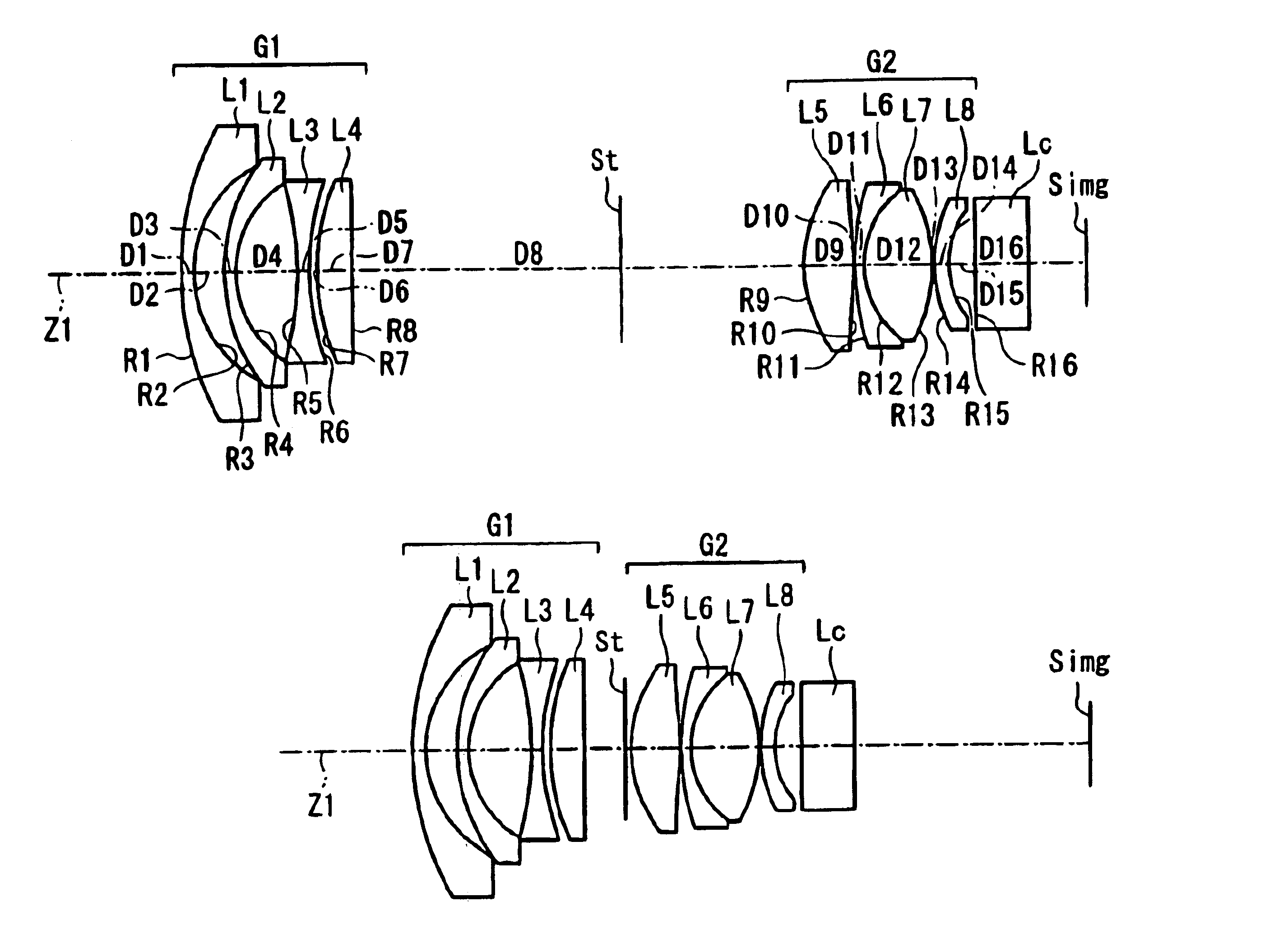Two-group zoom lens
a zoom lens and two-group technology, applied in the field of two-group zoom lenses, can solve the problems of high zoom ratio and inability to clearly focus images, and achieve the effects of reducing aberration, comparatively bright imaging, and favorable correction of aberrations
- Summary
- Abstract
- Description
- Claims
- Application Information
AI Technical Summary
Benefits of technology
Problems solved by technology
Method used
Image
Examples
embodiment 1
[0045]Table 1 below lists the surface number #, in order from the object side, the radius of curvature R (in mm) of each surface near the optical axis, the on-axis surface spacing D (in mm), as well as the refractive index Nd and the Abbe number vd (both at the d-line of 587.6 nm) of each lens element for Embodiment 1.
[0046]
TABLE 1#RDNdνd 123.041.001.7725049.6 29.262.37 313.940.901.7550052.3 48.004.78 5−25.390.901.7129953.8 620.120.59 717.252.641.8466523.8 81107.40D8 (variable) 9*9.873.761.5686758.2 10*−27.770.101119.110.801.8060933.3127.425.121.4970081.513−12.130.101411.211.101.8051725.4156.632.0016∞4.001.5168064.2The lens surfaces with a * to the right of the surface number in Table 1 are aspheric lens surfaces, and the aspheric surface shape of these lens elements is defined using Equation (A) above.
[0047]Table 2 below lists the values of the constants K, A4, A6, A8, and A10 used in Equation (A) above for each of the aspheric surfaces indicated in Table 1. Aspheric coefficients ...
embodiment 2
[0054]Embodiment 2 is very similar to Embodiment 1 and therefore only the differences between Embodiment 2 and Embodiment 1 will be explained. Embodiment 2 differs from Embodiment 1 in its lens element configuration such as different radii of curvature of lens surfaces, different eccentricities and aspheric coefficients of the aspheric lens surfaces, some different optical element surface spacings, some different refractive indexes, and some different Abbe numbers of the optical materials of the lens elements.
[0055]Table 5 below lists the surface number #, in order from the object side, the radius of curvature R (in mm) of each surface near the optical axis, the on-axis surface spacing D (in mm), as well as the refractive index Nd and the Abbe number vd (both at the d-line of 587.6 nm) of each lens element for Embodiment 2.
[0056]
TABLE 5#RDNdνd 125.311.001.8160046.6 210.851.87 317.210.901.8348042.7 47.824.65 5−22.360.901.7129953.8 642.970.10 719.102.551.8466523.8 8−646.83D8 (variable...
embodiment 3
[0064]Embodiment 3 is very similar to Embodiment 1 and therefore only the differences between Embodiment 3 and Embodiment 1 will be explained. Embodiment 3 differs from Embodiment 1 in its lens element configuration such as different radii of curvature of lens surfaces, different eccentricities and aspheric coefficients of the aspheric lens surfaces, some different optical element surface spacings, some different refractive indexes, and some different Abbe numbers of the optical materials of the lens elements.
[0065]Table 9 below lists the surface number #, in order from the object side, the radius of curvature R (in mm) of each surface near the optical axis, the on-axis surface spacing D (in mm), as well as the refractive index Nd and the Abbe number vd (both at the d-line of 587.6 nm) of each lens element for Embodiment 3.
[0066]
TABLE 9#RDNdνd 124.571.001.7725049.6 29.501.96 312.760.901.7858944.2 47.734.88 5−26.560.901.7725049.6 624.560.36 717.362.591.8466523.8 8427.90D8 (variable) ...
PUM
 Login to View More
Login to View More Abstract
Description
Claims
Application Information
 Login to View More
Login to View More - R&D
- Intellectual Property
- Life Sciences
- Materials
- Tech Scout
- Unparalleled Data Quality
- Higher Quality Content
- 60% Fewer Hallucinations
Browse by: Latest US Patents, China's latest patents, Technical Efficacy Thesaurus, Application Domain, Technology Topic, Popular Technical Reports.
© 2025 PatSnap. All rights reserved.Legal|Privacy policy|Modern Slavery Act Transparency Statement|Sitemap|About US| Contact US: help@patsnap.com



